An Investigation of the Frequency and Duration of a Drive Spoon–Dispersed Water Jet and Its Influence on the Hydraulic Performance of a Large-Volume Irrigation Sprinkler
Abstract
1. Introduction
2. Materials and Methods
2.1. High-Speed Photograph Test
2.2. Hydraulic Performance Test
3. Movement Theory of the Drive Arm
3.1. Analysis of the Drive Arm Movement Process
3.2. Formula for Calculating Duration
4. Results and Discussion
4.1. Comparison between Measured and Predicted Values from Theory
4.2. Influence on Hydraulic Performance
4.2.1. Comparison of Water Distribution Patterns
4.2.2. Comparison of Combined Uniformity Coefficients
5. Conclusions
Author Contributions
Funding
Data Availability Statement
Acknowledgments
Conflicts of Interest
References
- Xu, Z.D.; Li, H.; Xiang, Q.J.; Wang, J.H.; Jiang, Y.; Liu, J. Effect on combination irrigation of low pressure 20PY2 impact sprinkler with and without aeration. J. Drain. Irrig. Mach. Eng. 2022, 40, 74–79. [Google Scholar]
- Pei, S.S.; Li, Y.J.; Yan, H.J.; Gu, T. Effects of nitrogen treatments on potato nitrogen accumulation and soil nitrate-nitrogen distribution under sprinkler fertigation system. J. Drain. Irrig. Mach. Eng. 2022, 40, 745–750. [Google Scholar]
- Ouazaa, S.; Burguete, J.; Zapata, N. Solid-set sprinklers irrigation of field boundaries: Experiments and modeling. Irrig. Sci. 2016, 34, 85–103. [Google Scholar] [CrossRef][Green Version]
- Yan, H.J.; Hui, X.; Li, M.N.; Xu, Y. Development in sprinkler irrigation technology in China. Irrig. Drain. 2020, 69, 75–87. [Google Scholar] [CrossRef]
- Liu, J.P.; Zhu, X.Y.; Yuan, S.Q.; Li, H.; Tang, Y. Research and development trend of agricultural water-saving sprinkler and micro-irrigation equipment in China. J. Drain. Irrig. Mach. Eng. 2022, 40, 87–96. [Google Scholar]
- Pinto, M.A.B.; Parfitt, J.M.B.; Timm, L.C.; Faria, L.C.; Concenço, G.; Stumpf, L.; Nörenberg, B.G. Sprinkler irrigation in lowland rice: Crop yield and its components as a function of water availability in different phenological phases. Field Crops Res. 2020, 248, 107714. [Google Scholar] [CrossRef]
- Yuan, Y.; Lin, F.; Maucieri, C.; Zhang, Y. Efficient irrigation methods and optimal nitrogen dose to enhance wheat yield, inputs efficiency and economic benefits in the north China plain. Agronomy 2022, 12, 273. [Google Scholar] [CrossRef]
- Hua, L.; Jiang, Y.; Li, H.; Qin, L.T. Effects of different nozzle orifice shapes on water droplet characteristics for sprinkler irrigation. Horticulturae 2022, 8, 538. [Google Scholar] [CrossRef]
- Zhu, X.Y.; Yuan, S.Q.; Jiang, J.Y.; Liu, J.P.; Liu, X.F. Comparison of fluidic and impact sprinklers based on hydraulic performance. Irrig. Sci. 2015, 33, 367–374. [Google Scholar] [CrossRef]
- Mazzetto, F.; Calcante, A.; Orsi, E. Design, development, and evaluation of a device for the monitoring of liquid manure distribution using big gun sprinkler distribution systems. Appl. Eng. Agric. 2011, 27, 569–576. [Google Scholar] [CrossRef]
- Osman, M.; Hassan, S.B.; Yusof, K.B.W. Effect of combination factors of operating pressure, nozzle diameter and riser height on sprinkler irrigation uniformity. Appl. Mech. Mater. 2014, 695, 380–383. [Google Scholar]
- Sheikhesmaeili, O.; Montero, J.; Laserna, S. Analysis of water application with semi-portable big size sprinkler irrigation systems in semi-arid areas. Agric. Water Manag. 2016, 163, 275–284. [Google Scholar] [CrossRef]
- Ge, M.S.; Wu, P.T.; Zhu, D.L.; Zhang, L. Analysis of kinetic energy distribution of big gun sprinkler applied to continuous moving hose-drawn traveler. Agric. Water Manag. 2018, 201, 118–132. [Google Scholar] [CrossRef]
- Tang, P.; Li, H.; Issaka, Z.; Chen, C. Impact forces on the drive spoon of a large cannon irrigation sprinkler: Simple theory, CFD numerical simulation and validation. Biosys. Eng. 2017, 159, 1–9. [Google Scholar] [CrossRef]
- Yao, J.C.; Wang, X.K.; Zhang, S.C.; Xu, S.R.; Jin, B.B.; Ding, S.W. Orthogonal test of important parameters affecting hydraulic performance of negative pressure feedback jet sprinkler. J. Drain. Irrig. Mach. Eng. 2021, 39, 966–972. [Google Scholar]
- Tarjuelo, J.M.; Montero, J.; Honrubia, F.T.; Ortiz, J.J.; Ortega, J.F. Analysis of uniformity of sprinkle irrigation in a semi-arid area. Agric. Water Manag. 1999, 40, 315–331. [Google Scholar] [CrossRef]
- Liu, J.P.; Li, T.; Zhang, Q. Experimental study on influence of flow channel structure on hydraulic performance of low-pressure rotary sprinkler. J. Drain. Irrig. Mach. Eng. 2021, 39, 312–317. [Google Scholar]
- Liu, J.P.; Yuan, S.Q.; Li, H.; Zhu, X.Y. Numerical simulation and experimental study on a new type of variable-rate fluidic sprinkler. J. Agric. Sci. Tech. 2013, 15, 569–581. [Google Scholar]
- Burt, C.M.; Clemmens, A.J.; Strelkoff, T.S.; Solomon, K.H.; Bliesner, R.D.; Hardy, L.A.; Howell, T.A.; Eisenhauer, D.E. Irrigation performance measures: Efficiency and uniformity. J. Irrig. Drain. Eng. 1997, 123, 423–442. [Google Scholar] [CrossRef]
- Zhu, X.Y.; Yuan, S.Q.; Liu, J.P. Effect of sprinkler head geometrical parameters on hydraulic performance of fluidic sprinkler. J. Irrig. Drain. Eng. 2012, 138, 1019–1026. [Google Scholar] [CrossRef]
- Ge, M.S.; Wu, P.T.; Zhu, D.L.; Zhang, L. Application of different curve interpolation and fitting methods in water distribution calculation of mobile sprinkler machine. Biosyst. Eng. 2018, 174, 316–328. [Google Scholar] [CrossRef]
- Ge, M.S.; Wu, P.T.; Zhu, D.L.; Zhang, L. Comparisons of spray characteristics between vertical impact and turbine drive sprinklers—A case study of the 50PYC and HY50 big gun-type sprinklers. Agric. Water Manag. 2020, 228, 105847. [Google Scholar] [CrossRef]
- Kincaid, D.C. Impact sprinkler pattern modification. Trans. ASAE 1991, 34, 2397–2403. [Google Scholar] [CrossRef]
- Tarjuelo, J.M.; Montero, J.; Carrion, P.A.; Honrubia, F.T.; Calvo, M.A. Irrigation uniformity with medium size sprinklers part ii: Influence of wind and other factors on water distribution. Trans. ASAE 1999, 42, 677–690. [Google Scholar] [CrossRef]
- Silva, L.L. The effect of spray head sprinklers with different deflector plates on irrigation uniformity, runoff and sediment yield in a Mediterranean soil. Agric. Water Manag. 2006, 85, 243–252. [Google Scholar] [CrossRef]
- Li, H.; Jiang, Y.; Xu, M.; Li, Y.M.; Chen, C. Effect on hydraulic performance of low-pressure sprinkler by an intermittent water dispersion device. Trans. ASABE 2016, 59, 521–532. [Google Scholar]
- Li, H.; Liu, Z.C.; Tang, P.; Wang, C. Finite element analysis of arm of SR100 vertical impact sprinkler. J. Drain. Irrig. Mach. Eng. 2014, 30, 368–372. [Google Scholar]
- Issaka, Z.; Li, H.; Jiang, Y.; Tang, P.; Chen, C.; Darko, R.O. Hydraulic performance characteristics of impact sprinkler with a fixed water dispersion device. Int. J. Agric. Biol. Eng. 2018, 11, 104–112. [Google Scholar] [CrossRef]
- Pascal, M.; Kadem, N.; Tchiftchibachian, A. Investigation of the influence of sprinkler fins and dissolved air on jet flow. J. Irrig. Drain. Eng. 2006, 132, 41–46. [Google Scholar] [CrossRef]
- Jiang, Y.; Chen, C.; Li, H.; Xiang, Q.J. Influences of nozzle parameters and low-pressure on jet breakup and droplet characteristics. Int. J. Agric. Biol. Eng. 2016, 9, 22–32. [Google Scholar]
- Zhu, X.Y.; Zhang, A.Y.; Zhang, L.G.; Shi, Y.J.; Jiang, N. Research on atomization performance of low-pressure atomization nozzle. J. Drain. Irrig. Mach. Eng. 2021, 39, 210–216. [Google Scholar]
- Robles, O.; Playán, E.; Cavero, J.; Zapata, N. Assessing low-pressure solid-set sprinkler irrigation in maize. Agric. Water Manag. 2017, 191, 37–49. [Google Scholar] [CrossRef]
- AL-agele, H.A.; Mahapatra, D.M.; Nackley, L.; Higgins, C. Economic viability of ultrasonic sensor actuated nozzle height control in center pivot irrigation systems. Agronomy 2022, 12, 1077. [Google Scholar] [CrossRef]
- Tang, P.; Chen, C.; Li, H. Improving water distribution uniformity by optimizing the structural size of the drive spoon blades for a vertical impact sprinkler. Sustainability 2020, 12, 7574. [Google Scholar] [CrossRef]
- ASAE Standards, S330.1; Procedure for Sprinkler Distribution Testing for Research Purposes. 32nd ed. ASAE: Washington, DC, USA; St. Joseph, MI, USA, 1985.
- ASAE Standards, S398.1; Procedure for Sprinkler Testing and Performance Reporting. 32nd ed. ASAE: Washington, DC, USA; St. Joseph, MI, USA, 1985.
- ISO 7749-2; Agricultural Irrigation Equipment—Rotating Sprinklers—Part 2: Uniformity of Distribution and Test Methods. International Standards Organization: Geneva, Switzerland, 1990.
- King, B.A. Moving spray-plate center-pivot sprinkler rating index for assessing runoff potential. Trans. ASABE 2016, 59, 225–237. [Google Scholar]
- Wang, X.; Li, G.; Guo, C.C.; Han, W.T.; Yao, X.M.; Sun, Y. Optimization of impact sprinkler sub-nozzle parameters of elevation angle and position. Trans. CSAE 2015, 31, 89–95. [Google Scholar]
- Shi, Y.J.; Zhu, X.Y.; Hu, G.; Zhang, A.Y.; Li, J.P. Effect of water distribution on different working conditions for sprinkler irrigation. J. Drain. Irrig. Mach. Eng. 2021, 39, 318–324. [Google Scholar]
- El-Wahed, A.; Medici, M.; Lorenzini, G. Sprinkler irrigation uniformity: Impact on the crop yield and water use efficiency. J. Eng. Thermophys. 2016, 25, 117–125. [Google Scholar] [CrossRef]
- El-Marsafawy, S.M.; Swelam, A.; Ghanem, A. Evolution of crop water productivity in the Nile Delta over three decades (1985–2015). Water 2018, 10, 1168. [Google Scholar] [CrossRef]
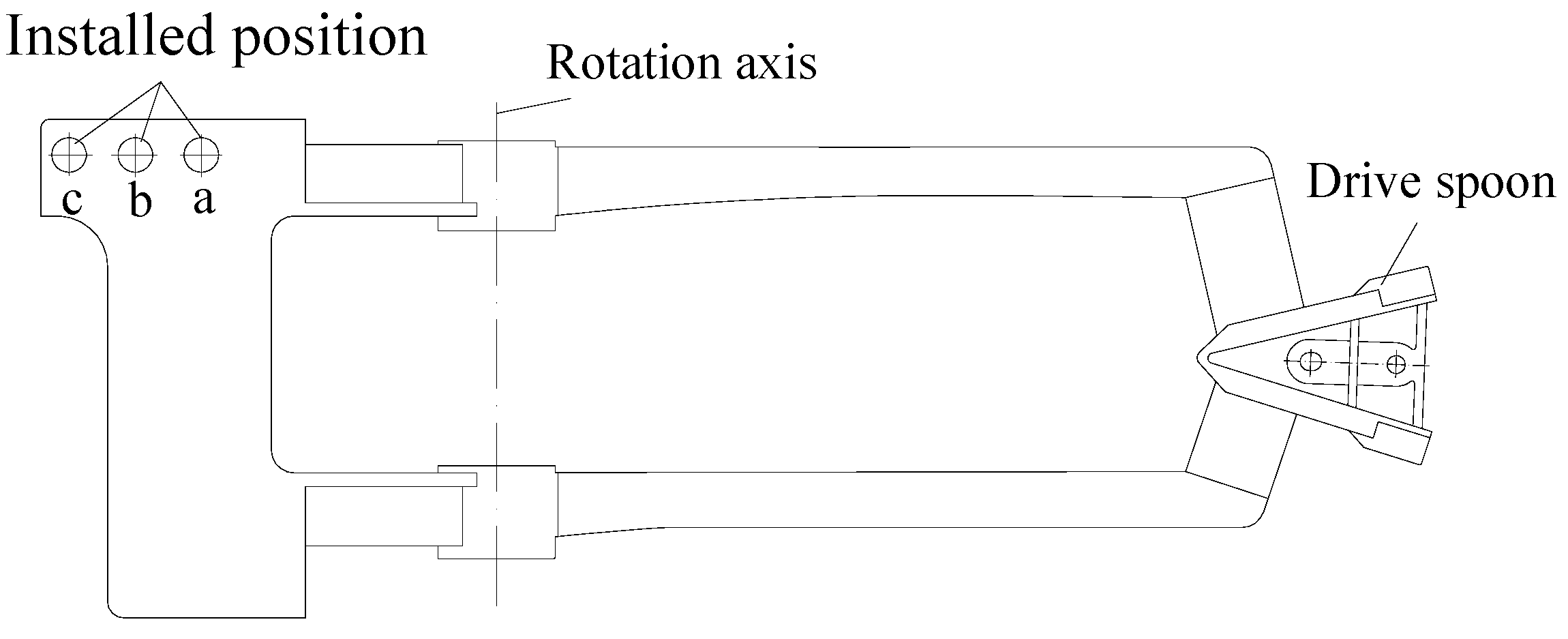
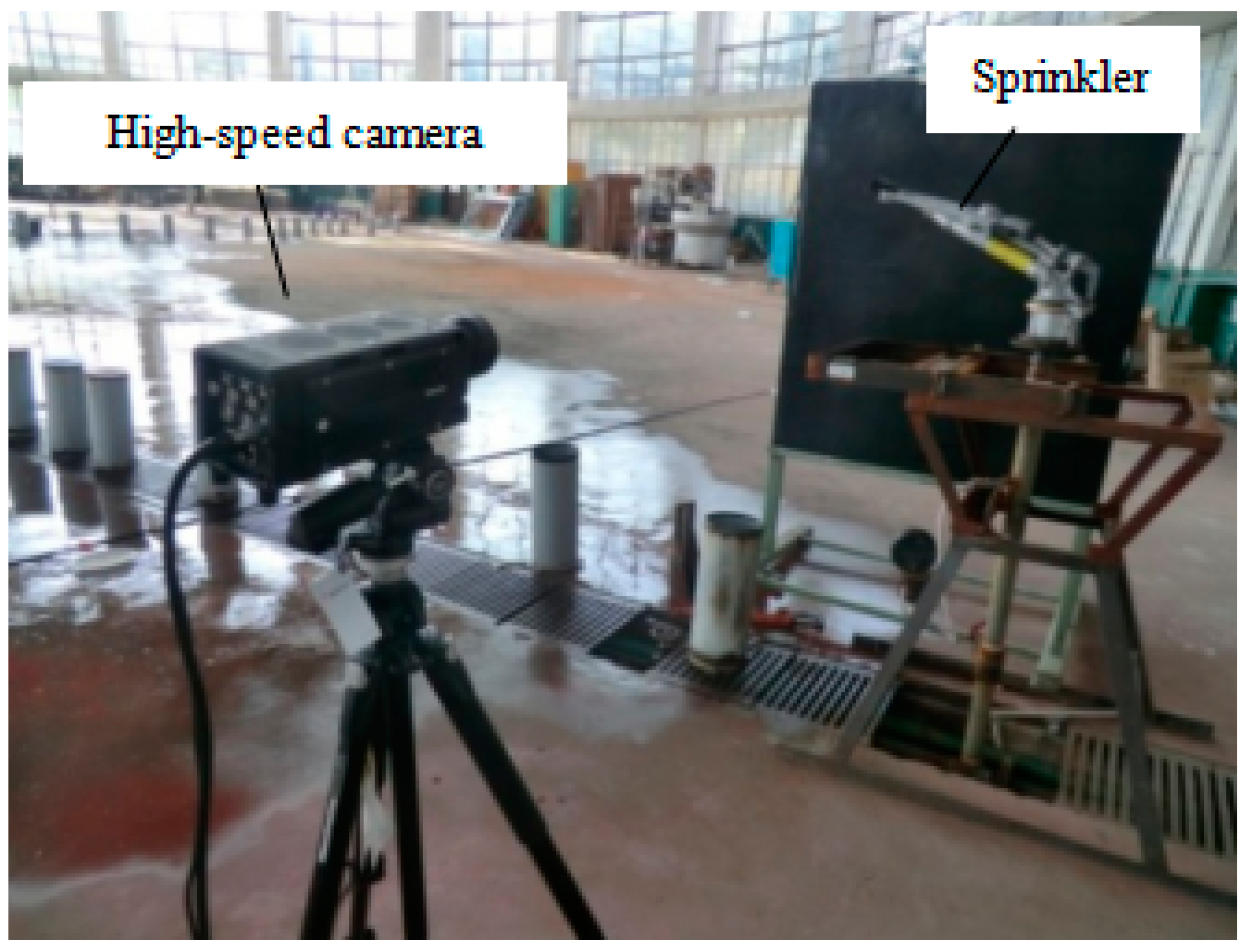

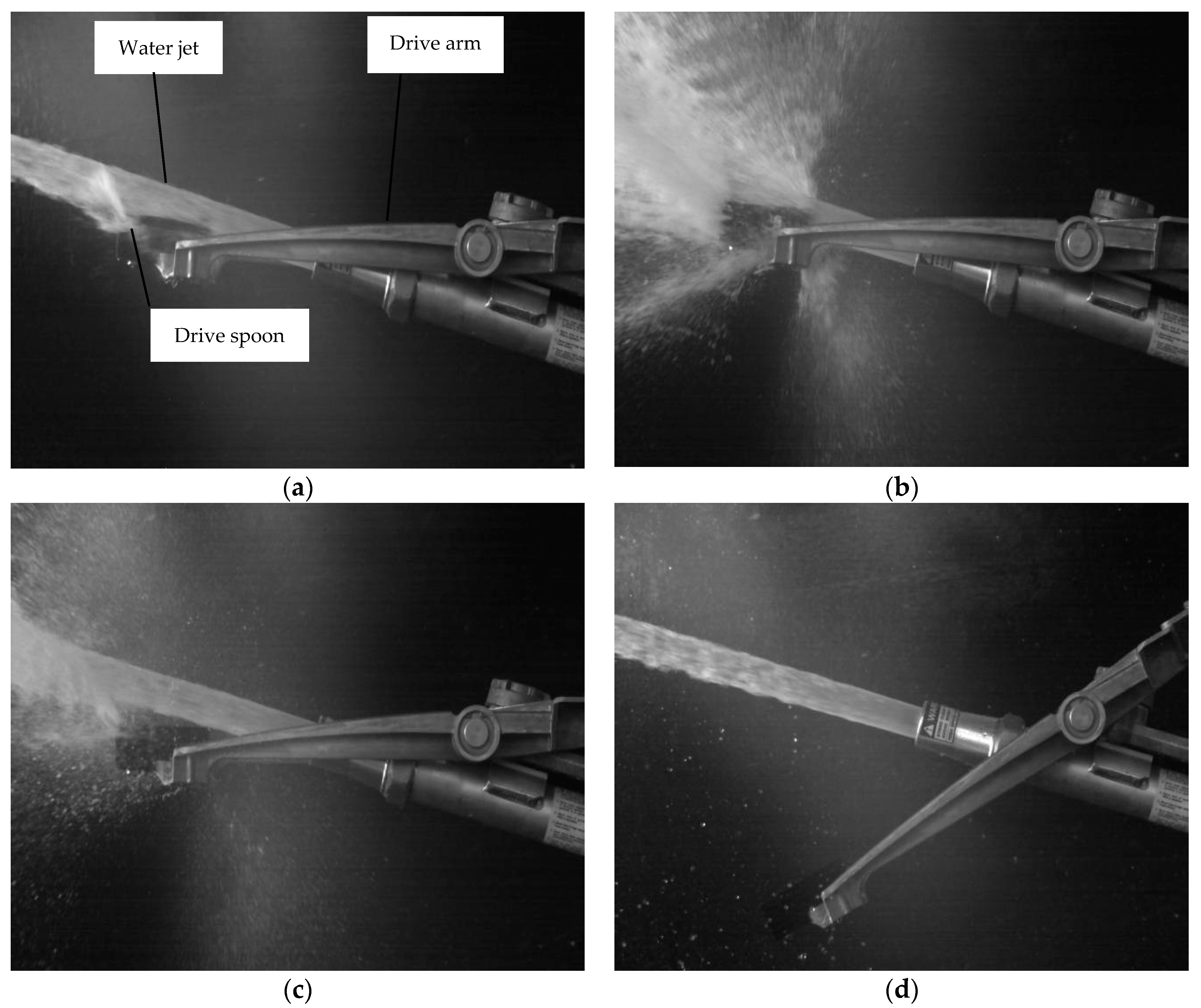
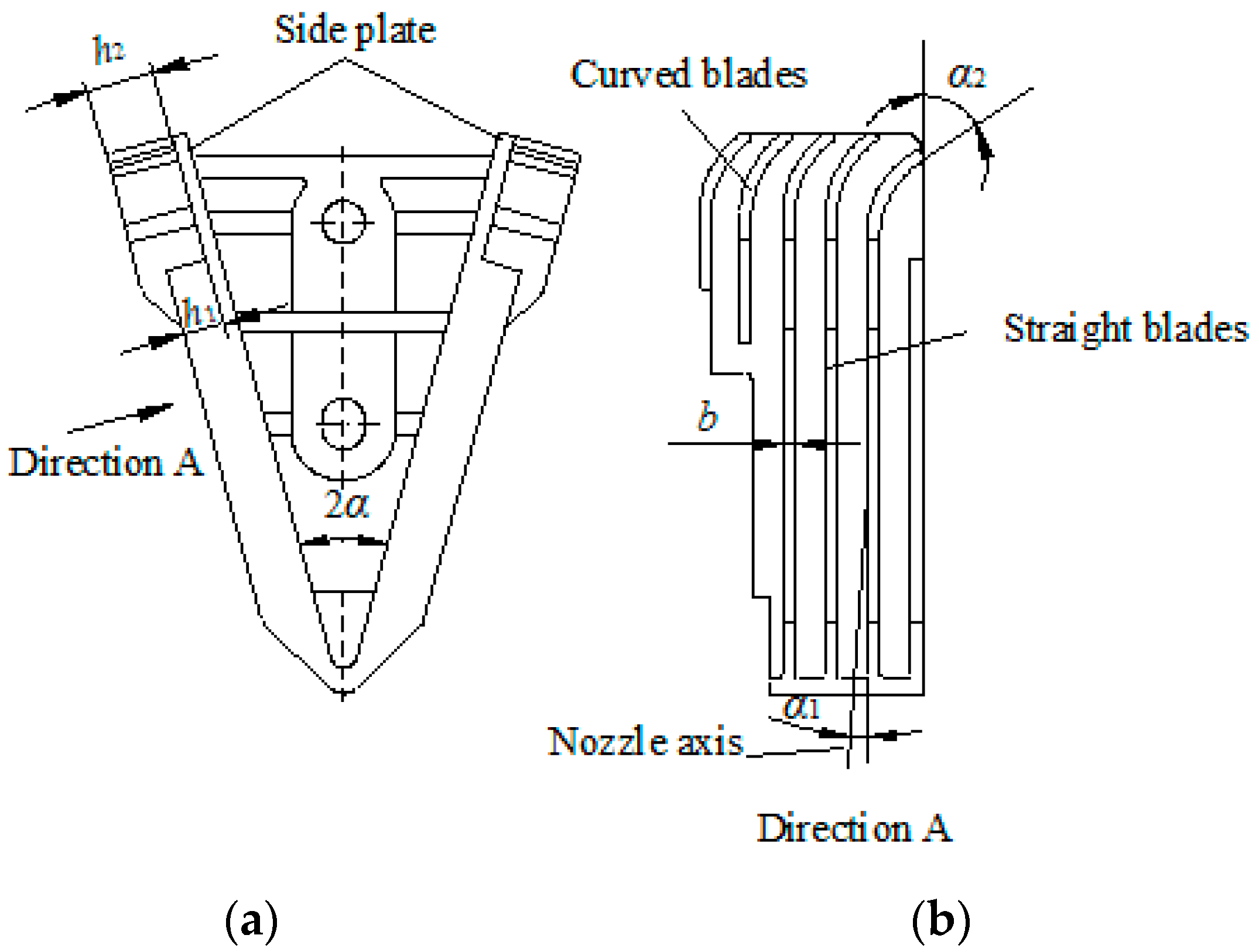
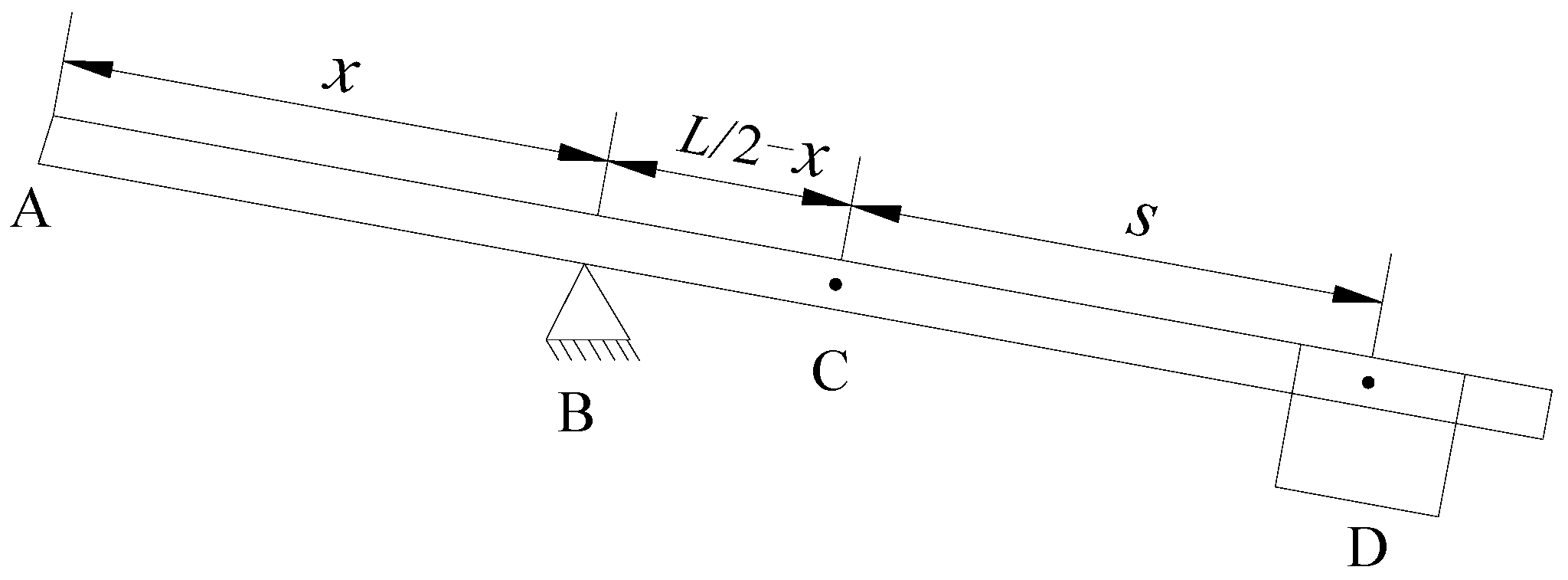
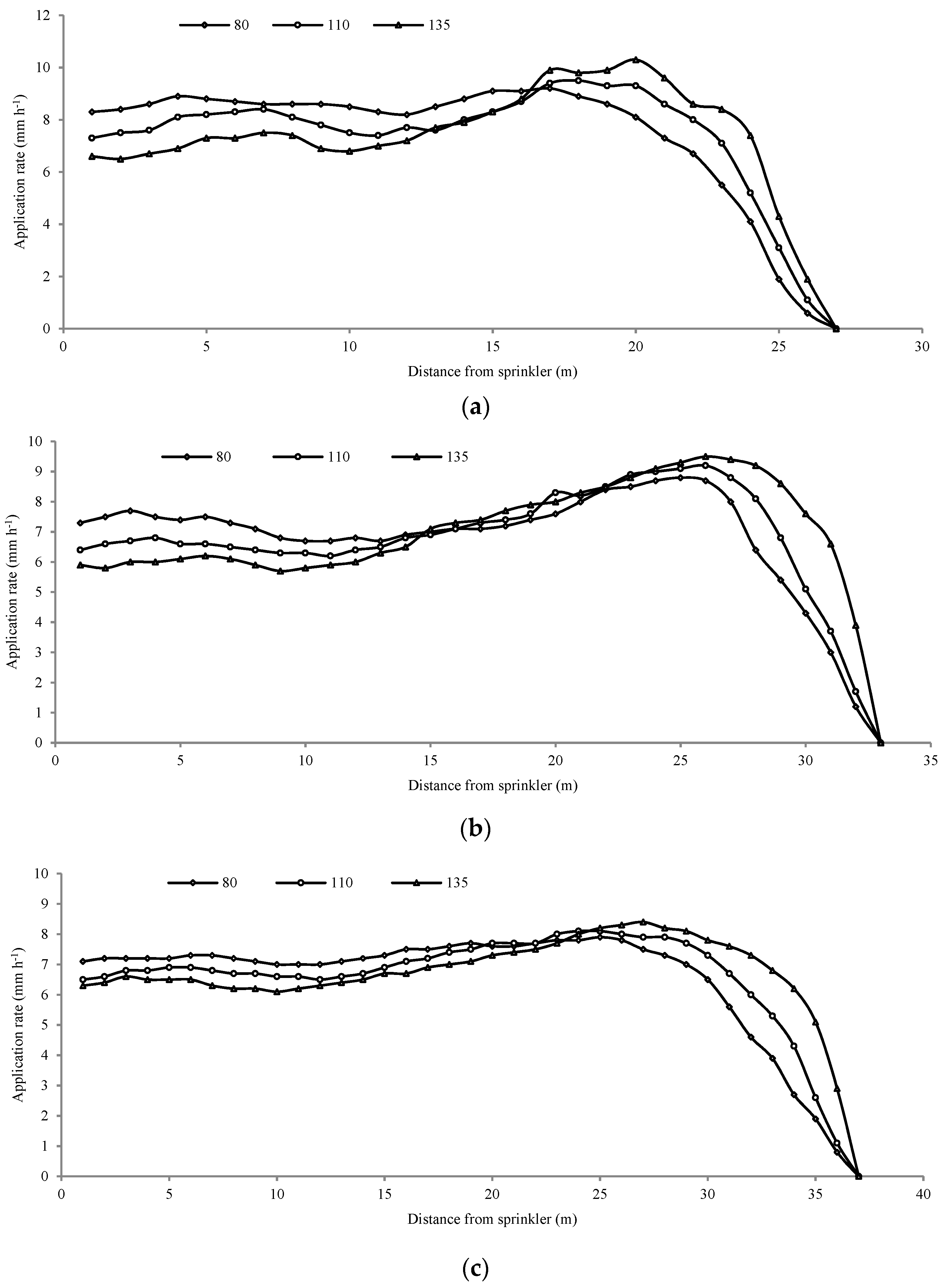
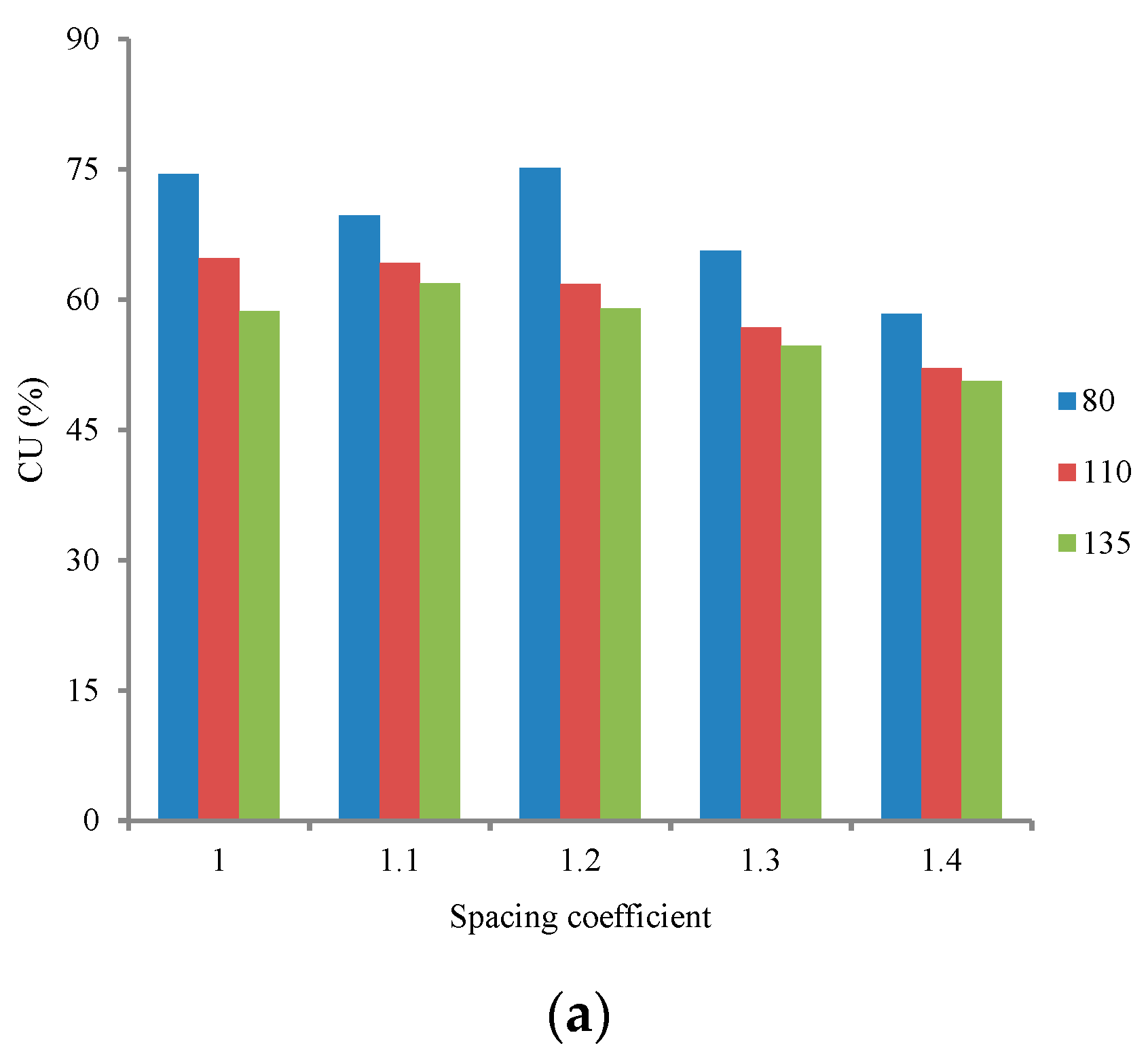

| d (mm) | b (mm) | h2 (mm) | α2 (°) | n | x (m) | θ(°) | m (kg) | M (kg) | L (m) |
|---|---|---|---|---|---|---|---|---|---|
| 25.5 | 1 | 10 | 45 | 5 | 0.325 | 2 | 0.7 | 0.74 | 0.49 |
| Working Pressure (MPa) | Distance between Counterweight- Installed Position and Rotation Axis (mm) | Frequency (Hz) | Duration Time | ||
|---|---|---|---|---|---|
| Calculated (s) | Measured (s) | Difference (%) | |||
| 0.30 | 80 | 1.210 | 0.0573 | 0.0530 | 8.11 |
| 110 | 1.165 | 0.0623 | 0.0572 | 8.92 | |
| 135 | 1.098 | 0.0673 | 0.0628 | 7.17 | |
| 0.35 | 80 | 1.293 | 0.0531 | 0.0503 | 5.57 |
| 110 | 1.243 | 0.0577 | 0.0550 | 4.91 | |
| 135 | 1.191 | 0.0623 | 0.0588 | 5.95 | |
| 0.40 | 80 | 1.320 | 0.0496 | 0.0482 | 2.90 |
| 110 | 1.268 | 0.0540 | 0.0527 | 2.47 | |
| 135 | 1.237 | 0.0583 | 0.0563 | 3.55 | |
Publisher’s Note: MDPI stays neutral with regard to jurisdictional claims in published maps and institutional affiliations. |
© 2022 by the authors. Licensee MDPI, Basel, Switzerland. This article is an open access article distributed under the terms and conditions of the Creative Commons Attribution (CC BY) license (https://creativecommons.org/licenses/by/4.0/).
Share and Cite
Tang, P.; Chen, C. An Investigation of the Frequency and Duration of a Drive Spoon–Dispersed Water Jet and Its Influence on the Hydraulic Performance of a Large-Volume Irrigation Sprinkler. Agronomy 2022, 12, 2233. https://doi.org/10.3390/agronomy12092233
Tang P, Chen C. An Investigation of the Frequency and Duration of a Drive Spoon–Dispersed Water Jet and Its Influence on the Hydraulic Performance of a Large-Volume Irrigation Sprinkler. Agronomy. 2022; 12(9):2233. https://doi.org/10.3390/agronomy12092233
Chicago/Turabian StyleTang, Pan, and Chao Chen. 2022. "An Investigation of the Frequency and Duration of a Drive Spoon–Dispersed Water Jet and Its Influence on the Hydraulic Performance of a Large-Volume Irrigation Sprinkler" Agronomy 12, no. 9: 2233. https://doi.org/10.3390/agronomy12092233
APA StyleTang, P., & Chen, C. (2022). An Investigation of the Frequency and Duration of a Drive Spoon–Dispersed Water Jet and Its Influence on the Hydraulic Performance of a Large-Volume Irrigation Sprinkler. Agronomy, 12(9), 2233. https://doi.org/10.3390/agronomy12092233





